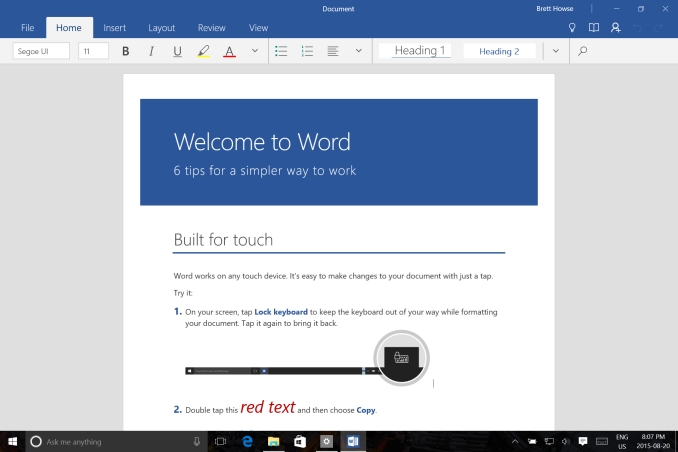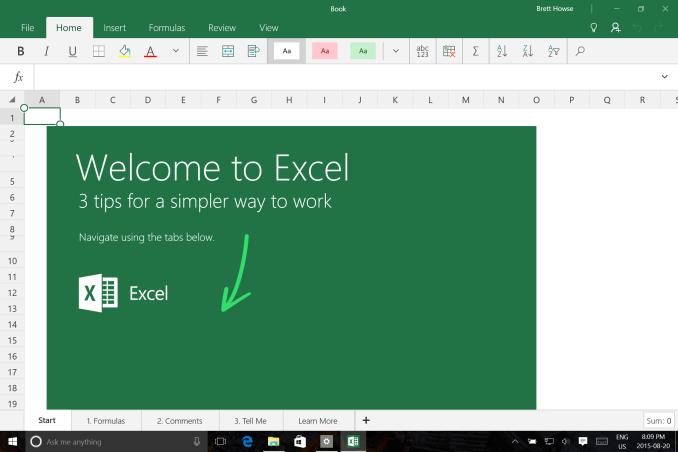The Windows 10 Review: The Old & New Face of Windows
by Brett Howse on August 25, 2015 8:00 AM EST- Posted in
- Operating Systems
- Microsoft
- Windows 10
Touch-Enabled Office Apps Arrive with Windows 10
When Windows 8 launched, Microsoft had built a touch-first version of their operating system, but they had not yet completed their touch-enabled version of their most popular productivity suite. In fact, in the almost three years between Windows 8 and Windows 10, Microsoft released Office on iOS first, and then Android, leaving their own platform as the only one without a touch-enabled version of Office. Finally, with Windows 10, Office Mobile is here.
These are, like practically all pieces of Windows 10, Windows Universal Apps, and therefore they are made to scale all the way from a phone to a large display desktop. Word, Excel, PowerPoint, and OneNote are all available. The experience is very similar to how it looks on the other platforms, and Microsoft has done a nice job keeping the look and feel consistent across the different mobile operating systems.
I think most people are familiar with the Office trio of Word, Excel, and PowerPoint, and perhaps not quite as familiar with OneNote, but the mobile apps are surprisingly competent versions, and can likely easily replace the full Office suite for a lot of people. If you need some of the extra functionality like conditional formatting in Excel, or the ability to open password protected documents, you will need to go with the full version of Office, at least for now.
In pretty typical Microsoft fashion, the apps have been created to allow basic file reading, creation, and editing for free, but if you want to access all of the features you need to purchase an Office 365 subscription. There is a big caveat here though. This only applies to devices under 10.1 inches in screen diameter. Anything larger than this requires a subscription to gain access to edit, which is a pretty big concession. According to Microsoft, they want to keep the free capabilities available for devices that are mostly used with touch, and the Office team feels this cut-off is 10.1 inches. Amazingly, the same company also sells a consumer version of their tablet line, the Surface 3, which is a 10.8 inch device and therefore over the cut-off. They do sell it with a one year subscription, but it’s a rather odd way to market the new Office Mobile apps.
There is also a new piece to the Office puzzle, which is called Sway. Luckily, like OneNote, Sway is free for all users. So what is Sway? It is an interactive storytelling app, and it lets you easily add some text and media, and it will create a sway for you. It’s very much a cloud based app, and you can share links to your sway to view or edit. Think of it like a simpler version of PowerPoint. Here is a sway as an example of what it can do.
OneNote is of course back, and this is Microsoft’s app which lets you do a lot more than just take notes. The touch version is changed from Windows 8, and it now fits in with the theme of the other Office Mobile apps. Fans of the Windows 8 version’s radial menu will be disappointed though since that has gotten the axe.
I think the capabilities of these apps are going to improve over time, but it is unlikely they will ever offer the full functionality of the desktop version of Office. They are targeted towards a different set of needs. It was certainly one of the key missing pieces of the Windows 8 era, so it is great that they have made their debut with Windows 10. Only OneNote is installed out of the box, and the other apps can be found in the store.














293 Comments
View All Comments
Notmyusualid - Tuesday, August 25, 2015 - link
+1Victor84 - Tuesday, August 25, 2015 - link
I upgraded from Windows 8 but ran into so many bugs and strange problems that I downgraded after a couple of hours.cjs150 - Tuesday, August 25, 2015 - link
I have been using w10 for a couple of weeks now. It feels a bit quicker than w8, but somewhat to my surprise I find I am missing the live tiles start screen.Multiple virtual desktops is a wonderful, and long overdue, feature. Edge is very nice (but I still went back to Chrome).
Now the bad points:
1. File explorer. Other than cosmetic changes it has not been overhauled for decades and it shows
2. Groove music, Brett may like it, I don't. It would not update my music collection without logging in to my Microsoft account (which I do not use except when forced to) when I ticked box to log into that application only, W10 ignored me switched my entire account to the Microsoft account (which took ages to find the disconnect option). Its ability to correctly tag my music collection (sadly all WAV) is the same as media player, which is to say total crap. It is a big waste of space.
3. Windows Media Centre - bring it back I miss it!
4. New start menu. I got used to not having it in w8, the new version is clunky, bug ridden and I am sure that the use of live tiles is solely because MS is too embarrassed to ditch them. I guess I will be buying Stardock start10 or similar third party replacement.
Overall a nice upgrade from Vista but not really worth it for w7 or 8
chrome_slinky - Wednesday, August 26, 2015 - link
Tiles are not because of embarrassment. Tiles are there because of hubris. They want you to have things their way, whether you like it or not.sorten - Tuesday, August 25, 2015 - link
"Windows 8 works well in a touch scenario, but is not ideal for keyboard and mouse based devices."Brett, this is an interesting comment. Which mouse and keyboard features weren't working for you in Windows 8? I used Windows 8 on my home desktop from beta and my mouse and keyboard worked fine. I stopped using the Start button with Windows Vista because the search feature is much quicker, but even the missing Start button was fixable with 3rd party options.
Oh well, on to Windows 10. Hopefully people try it before condemning it. Based on the tinfoil hat comments above I'm guessing they won't.
Brett Howse - Tuesday, August 25, 2015 - link
I mean let's not open this debate again, but yes it works with a keyboard and mouse, but it is less than productive when you are in Windows Explorer, double click a photo to look at it, and a full screen photos app pops up and you can't see what you are doing anymore. There were so many of these examples. Everything worked yes, but productivity was not what it needed to be on that form factor.I mean think about out of the box Windows 8 and trying to reference a PDF. Windows Reader would open it full screen, and you would have to snap the desktop to half of the screen to work with it, and muck around with your windows. The solution that we all did was to stop using the new apps and go back to things like Adobe Reader on the desktop, but that's not a win for the platform and its new app model. If the new app model is not one that everyone uses, then you will never get quality apps built for it because it would only be available for a subset of users.
chrome_slinky - Wednesday, August 26, 2015 - link
I got rid of it 3 days after launch, as I had been running it since February, and could take the irk no more. I would LOVE to see someone compile a list of the places where a right click has always produced a result, and no longer does anything - far from the BS about how the device will dictate the interface, which, if you think at all, means that desktop users should see no change in the way it works for them. That, of course, is NOT the case, proving the lie from Microshaft, and also showing they are either incapable or too lazy to implement things they had said they were going to.Notmyusualid - Tuesday, August 25, 2015 - link
PROUD 'Tin foil hatter' here...chrome_slinky - Wednesday, August 26, 2015 - link
Paid troll?Michael Bay - Wednesday, August 26, 2015 - link
Your envy is obvious.